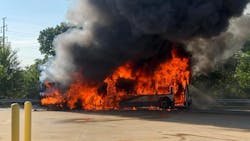NTSB Joins Investigation of CT Electric Bus Fire
By Abigail Brone
Source The Hour, Norwalk, Conn. (TNS)
Aug. 1—It's rare for an electric bus to burst into flames in the way a state-operated one did last month at a Hamden bus depot, but the same can't be said for all electric vehicles, according to industry experts.
And the National Transportation Safety Board, a federal agency that investigates significant transportation accidents, has joined the efforts to determine the exact cause of the fire.
"Working with Connecticut State Police and state officials, NTSB is investigating a fire that consumed a CTtransit battery electric bus ( July 23) in Hamden, Connecticut. The bus was in a maintenance facility at the time," the NTSB tweeted Friday afternoon.
The fire, which destroyed one of CTtransit's dozen electric buses, was the first of its kind for the state's fleet. The rest of the electric fleet was pulled from service since then.
"Lithium ion battery fires are difficult to extinguish due to the thermal chemical process that produces great heat and continually reignites," Hamden fire officials said. Two transit workers exposed to the smoke from the fire were hospitalized as a precaution, and a firefighter was also taken to the hospital with heat exhaustion, officials said.
State officials, manufacturers and the NTSB are conducting parallel investigations, Department of Transportation spokesperson Josh Morgan said.
" NTSB has initiated an investigation that will run parallel with the Connecticut State Police fire origin and cause investigation," Morgan said. "CTDOT, CTtransit, New Flyer and other federal agencies are all participating in the investigations."
The bus was delivered in December and began service in January, CTtransit spokesperson Josh Rickman previously said. It was made by New Flyer and the battery was by XALT Energy, Rickman said.
"The bus, last operated on July 20, on routes 243 and 265, was not in service at the time of the incident," Rickman said Monday. "Bus fires are rare but can occur similar to cars. This is CTtransit's first fire incident with a battery electric bus. Bus operators, maintenance staff and others undergo extensive training and safe protocols are in place."
The electric fleet will be sent back on the road pending the results of the investigations, which are not yet complete, Rickman said.
Electric combustion
Electric vehicle fires and combustion are common, chemical engineer Christine Lampe-Onnerud said. Lampe-Onnerud is the founder and CEO of Cadenza Innovation, a Danbury-based company that produces safe, high-energy-density, low-cost batteries and energy storage options to transportation, utility and commercial/industrial markets.
Lampe-Onnerud is working on a battery that can be used in electric vehicles and homes that would prevent a fire or explosion should one compartment of the battery malfunction.
"I was devastated to see the failure," Lampe-Onnerud said. "We are in tectonic technology shift, and there will be errors and should be some humility in it. We will learn together as a community. We have to stay agile in what we are looking for."
The DOT and the state Department of Energy and Environmental Protection have the right idea in moving to lessen the state's environmental footprint, Lampe-Onnerud said, but the fire presents an opportunity to step back and reevaluate the deployment.
"If you look at cellphones, these things happen roughly 1 in every 7 million to 10 million. The market accepted that as the failure rate," Lampe-Onnerud said. "For electric vehicles it's roughly every 1,000 to 2,000. Is that acceptable? Probably not."
The cause of the fire is unlikely to be related to the severe heat and drought conditions, Lampe-Onnerud said.
"It's probably a design and manufacturing error, but maybe we should be kinder to the previous players and say it's a learning experience," Lampe-Onnerud said. "It's not fine in buses or electric vehicles, or when you put it in a house or basement. ... We cannot have a battery that is supposed to lower fossil fuel and instead create incineration opportunities."
Keeping the electric fleet off the roads until the cause is determined and the other vehicles can be evaluated is the right move, Lampe-Onnerud said.
However, she hopes the unfortunate incident does not deter the state and community from embracing electric vehicles.
E-bus fires
While battery malfunctions and fires occur regularly for electric cars, it is less common in electric buses.
EV FireSafe is a research project that identifies the risks to emergency responders attending an electric vehicle (EV) lithium traction battery fire, particularly where that vehicle is connected to a charging station.
"Our research has found at least 18 verifiable e-bus high voltage battery fires globally since 2010, in a stock of over 110,000 vehicles," according to EV FireSafe report findings.
Of the 18 identified electric bus fires globally: six of the buses were parked at a bus depot, as in Hamden; six led to other vehicles or electric buses catching fire; five were connected to charging ports; and one was an e-bus vapor cloud explosion, according to EV FireSafe.
A March 2022 study by Propulsion report found "the global electric bus market size is projected to grow from 112,041 units in 2022 to reach 671,285 units by 2027," according to EV FireSafe. North America is the fastest growing market for electric buses, while the Asian Pacific is the overall largest market.
Asia has the largest number of electric buses, and many of the 18 identified fires took place there, including several in China, according to EV FireSafe.
Earlier this year, Paris suspended its e-bus fleet after two electric buses caught fire in separate events three weeks apart, according to the Institute for Energy Research. The two buses were of the same make and model.
In 2016, one the five electric buses in Frederick County, Md., caught fire in a bus depot after it was connected to an improperly crimped wire, according to the Frederick News-Post.
___
(c)2022 The Hour (Norwalk, Conn.)
Visit The Hour (Norwalk, Conn.) at www.thehour.com
Distributed by Tribune Content Agency, LLC.






